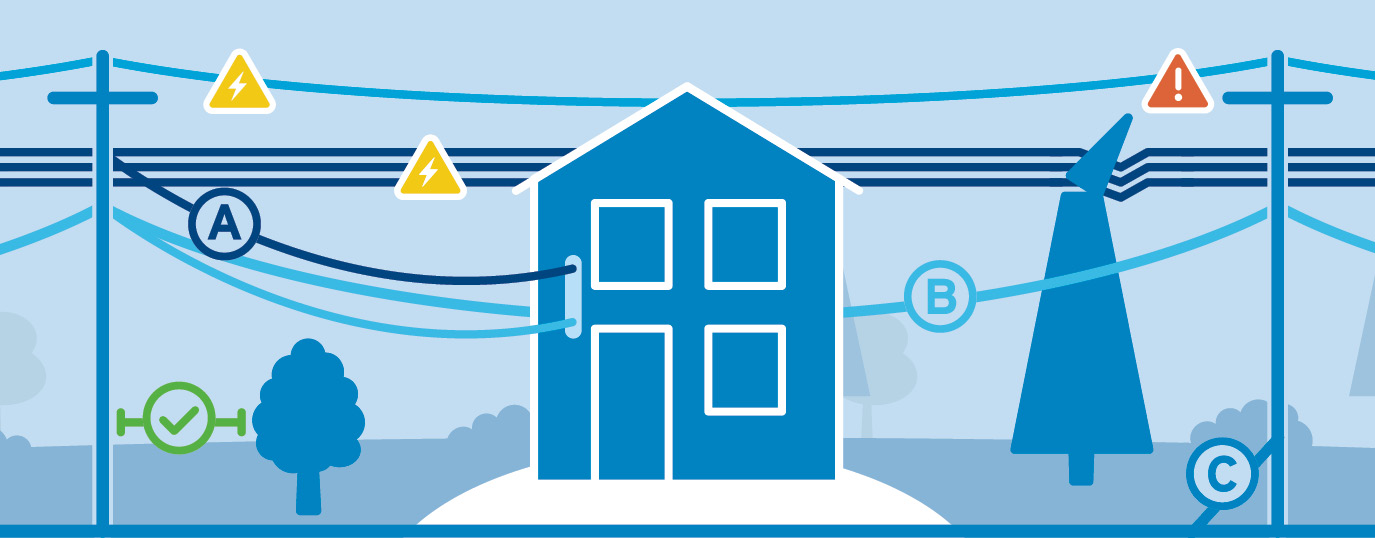Tree Trimming
We are actively responding to a cyber incident and working around the clock to restore all systems safely and securely.
We apologize for this inconvenience and thank you for your patience. We will post updates on nspower.ca as we make progress and restore all services.
Customer Requested Tree Trimming
We sometimes receive customer requests to trim trees on and around private property. For these requests, we focus on individual trees that pose an immediate risk to power lines.
Our planned vegetation management program commits to our longer term maintenance of trees near service and transmission lines across the province to help ensure overall system reliability for our customers. To learn more, click here.
Please call us at 1-800-428-6230 to request tree trimming service.
When to Submit a Tree Trimming Request?
Emergency situations require our immediate attention. A tree laying on a power line can cause flickering lights in the home or damage to a utility pole and equipment. If you see this kind of situation, please call us immediately
on our 24-hour power outage line at 1-877-428-6004.
Non-emergency situations are determined if there is no immediate threat to power lines, refer to the diagram below to learn more about trees that are within Nova Scotia Power’s responsibility or yours as a homeowner.

NOVA SCOTIA POWER RESPONSIBILITY
![]() These wires are high voltage and dangerous. It is Nova Scotia Power’s responsibility to maintain safe clearance around these wires for the health of the electrical system.
These wires are high voltage and dangerous. It is Nova Scotia Power’s responsibility to maintain safe clearance around these wires for the health of the electrical system.
![]() Emergency situations require Nova Scotia Power’s immediate attention. A tree laying on a power line can cause flickering lights in the home or damage to a utility pole and equipment. If you see this kind of situation,
please call us immediately at 1-877-428-6004.
Emergency situations require Nova Scotia Power’s immediate attention. A tree laying on a power line can cause flickering lights in the home or damage to a utility pole and equipment. If you see this kind of situation,
please call us immediately at 1-877-428-6004.
HOMEOWNER RESPONSIBILITY
These wires require a local contractor to complete the tree work needed around them.
![]() A lower-voltage service wire brings electricity from the street power pole through to a mast on your house, which belongs to you. Trees around service wires could damage your mast and cause a power interruption to your home.
Trimming is your responsibility. Qualified contractors are able to work around service wires.
A lower-voltage service wire brings electricity from the street power pole through to a mast on your house, which belongs to you. Trees around service wires could damage your mast and cause a power interruption to your home.
Trimming is your responsibility. Qualified contractors are able to work around service wires.
![]() Communication wires (with black insulation around them) are the lower wires that run along the street and into your house, transmitting phone, cable and Internet signals. These are not electrical wires. Trees around these
wires do not threaten the electrical system.
Communication wires (with black insulation around them) are the lower wires that run along the street and into your house, transmitting phone, cable and Internet signals. These are not electrical wires. Trees around these
wires do not threaten the electrical system.
![]() Support cables provide physical support to utility poles. These are not electrical wires. Trees or bushes around these wires do not threaten the electrical system.
Support cables provide physical support to utility poles. These are not electrical wires. Trees or bushes around these wires do not threaten the electrical system.
Tree Planting Advice
The right tree in the right place.
There are lots of great benefits to having trees in our communities. That’s why we work with you to find trees that work well near power lines. We want to make sure your family stays safe and avoid unnecessary power outages. To help you choose the right trees, we and our partner Landscape Nova Scotia created the Plant the Right Tree in the Right Place program. Together, we’ll help you find safe ways to use trees when landscaping near power lines.
Many trees are safe to plant near power lines:
- Young’s Weeping Birch
- Weeping Siberian
- Pea-Shrub
- Catalpa Umbrella Tree
- Globe Maples
- Service Berry
- White Fringetree
- Toba Hawthorn
- Purple Weeping Beech
- Tree Form Hydrangea
- Kwanzan Cherry
- Newport Plum
- Weeping Mulberry
- Weeping Goat Willow
- Witchhazel
- Japanese Maples
- Japanese Stewartia
- Golden Chain Tree
Evergreens:
- Emerald Cedar
- Holmstrup Cedar
- Unicorn Cedar
- Moffet Blue Juniper
- Skyrocket Juniper
- Ontario Green Juniper
- Spartan Juniper
- Dwarf White Pine
- Dwarf Ohlendorffii Spruce
- Dwarf Serbian Spruce
- Nest Spruce
- Montgomery Blue Spruce
Flowering Crabapples:
- Candymint
- Madonna
- Pink Spires
- Prairie Fire
- Profusion
- Indian Magic
- Selkirk
- Snowdrift
- Weeping Flowering Crab
- Red Splendor
Magnolias:
- Alexandrina
- Betty
- Dr. Merrill
- Royal Star
- Susan Lenard
- Messel Saucer
Flowering Dogwoods:
- Satomi
- Kousa Chinensis
Making the right tree choice offers great benefits.
- You’ll help prevent safety hazards and power outages. You’ll also reduce the need for tree and limb cutting around power lines.
- Trees screen and buffer utility lines in residential areas and have a direct effect on the environment by removing carbon dioxide, generating oxygen and capturing dust and smog particles.
- Trees have cooling effects through providing shade during the hot summer months and reduce energy costs for air-conditioning and water use.
- Large trees promote wildlife habitats in our communities.
How we're investing in our system
To continue to improve reliability for our customers, our plans include increasing our tree trimming investment year-over-year and nearly doubling our annual investment over the next five years.
Tree trimming in your community >


